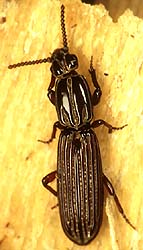
Clinidium is a genus of wrinkled bark beetles in the subfamily Rhysodinae. Most species are Neotropical, but some occur further north in North America and there is also one species in Europe and one in Japan. Two species are known from Miocene amber.
Clinidium blomi is a species of ground beetle in the subfamily Rhysodinae. It was described by R.T. Bell in 1970. It is endemic to the High Plateau of Chiapas in southeastern Mexico.
Clinidium boroquense is a species of ground beetle in the subfamily Rhysodinae. It was described by R.T. Bell in 1970. It is endemic to Puerto Rico.
Clinidium chiolinoi is a species of ground beetle in the subfamily Rhysodinae. It was described by R.T. Bell in 1970. It is endemic to Jamaica. Clinidium chiolinoi measure 4.4–5.6 mm (0.17–0.22 in) in length.
Clinidium corbis is a species of ground beetle in the subfamily Rhysodinae. It was described by R.T. Bell in 1970. It is endemic to Hispaniola. Clinidium corbis measure 4.4–5.5 mm (0.17–0.22 in) in length.
Clinidium darlingtoni is a species of ground beetle in the subfamily Rhysodinae. It was described by R.T. Bell in 1970. It is endemic to Jamaica.
Clinidium haitiense is a species of ground beetle in the subfamily Rhysodinae. It was described by R.T.Bell in 1970. It is known from La Selle Range in Haiti. Clinidium haitiense measure 5.7–6.4 mm (0.22–0.25 in) in length.
Clinidium rosenbergi is a species of ground beetle in the subfamily Rhysodinae. It was described by R.T. Bell in 1970. It is endemic to the United States, primarily to the eastern United States east to the Appalachian Mountains, but it reaches the Delaware River in Pennsylvania and is found west of the Mississippi River in Missouri.
Clinidium rossi is a species of ground beetle in the subfamily Rhysodinae. It was described by Ross Bell in 1970. It is known from Golfito in Costa Rica. The holotype, a male, measures 4.1 mm (0.16 in) in length.
Clinidium valentinei is a species of ground beetle in the subfamily Rhysodinae. It was described by R.T. Bell in 1970. It is endemic to the Appalachian Mountains in the eastern United States, from northern Alabama to southwestern Pennsylvania.
Clinidium xenopodium is a species of ground beetle in the subfamily Rhysodinae. It was described by R.T. Bell in 1970. It is endemic to the Dominican Republic (Hispaniola).

Clinidium baldufi is a species of ground beetle in the subfamily Rhysodinae. It was described by R.T. Bell in 1970. It is endemic to the central and eastern United States, east of central Iowa, southeastern Missouri and southwestern Mississippi, as far south as northern Florida, and north to northern Illinois, Pennsylvania, and New Jersey.
Clinidium centrale is a species of ground beetle in the subfamily Rhysodinae. It was described by Antoine Henri Grouvelle in 1903. It is endemic to Costa Rica. Clinidium centrale measure 6–7.4 mm (0.24–0.29 in) in length.
Clinidium integrum is a species of ground beetle in the subfamily Rhysodinae. It was described by Antoine Henri Grouvelle in 1903. It is known from its type locality in western Amazonas state, Brazil, and from Leticia in Amazonas Department, Colombia.
Clinidium mathani is a species of ground beetle in the subfamily Rhysodinae. It was described by Antoine Henri Grouvelle in 1903. Originally known from the Amazon Basin of Brazil—its type locality is in the Amazonas State, near the border with Peru and Colombia, and there is another record from Amapá—it is now also known from the Colombian Andes in the Cordillera de los Picachos National Natural Park (Caquetá) and from near Inzá (Cauca). It is named after collector of the holotype, M. de Mathan.
Clinidium canaliculatum is a species of ground beetle in the subfamily Rhysodinae. It was described by O.G. Costa in 1839. It is found in southern Italy and in Greece and is an obligate saproxylic species associated with old-growth forests, with preference to wet biotopes with well-decayed wood. Clinidium canaliculatum measure 6–7.5 mm (0.24–0.30 in) in length.
Clinidium granatense is a species of ground beetle in the subfamily Rhysodinae. It was described by Louis Alexandre Auguste Chevrolat in 1873. It is known from Colombia.
Clinidium extrarium is a species of ground beetle in the subfamily Rhysodinae. It was described by R.T. & J.R. Bell in 1978. The type series originates from "N. Amerika"; the specific locality is unknown but likely was in the tropical lowlands of Mexico or northern Central America.
Clinidium guatemalenum is a species of ground beetle in the subfamily Rhysodinae. It was described by David Sharp in 1899. It is endemic to Guatemala.

Clinidium marginicolle is a species of ground beetle in the subfamily Rhysodinae. It was described by Edmund Reitter in 1889. It is known Azerbaijan and northeastern Iran.

